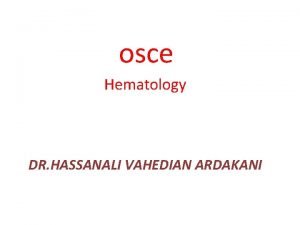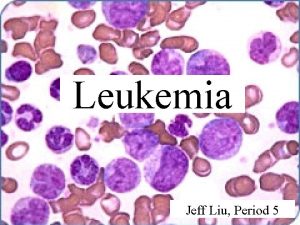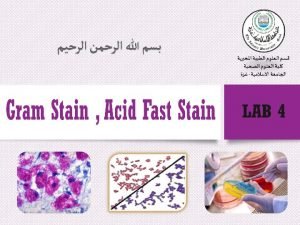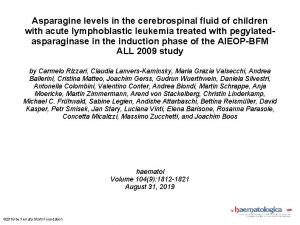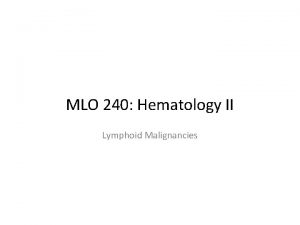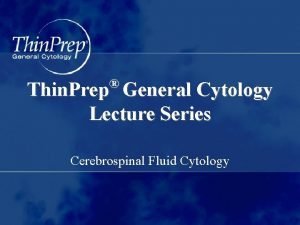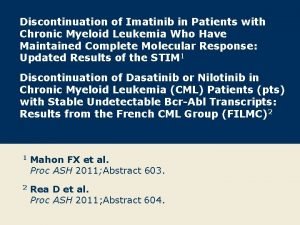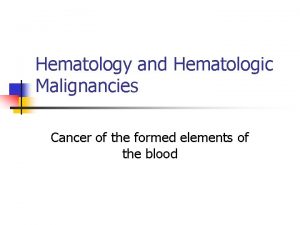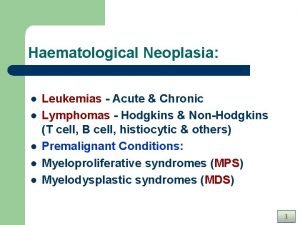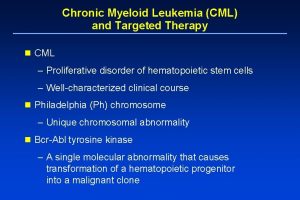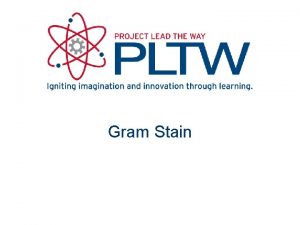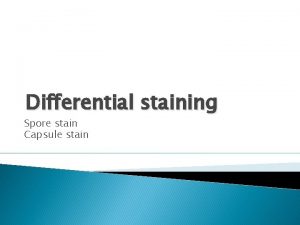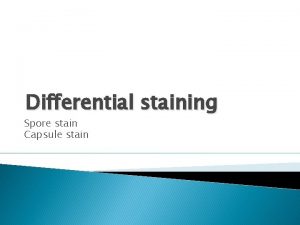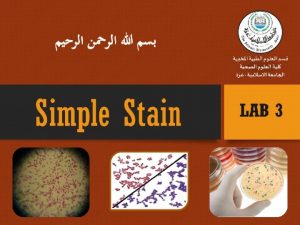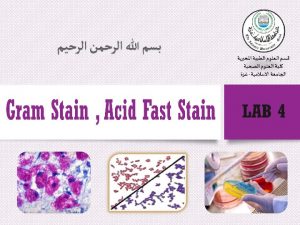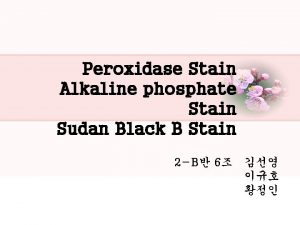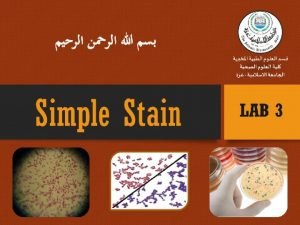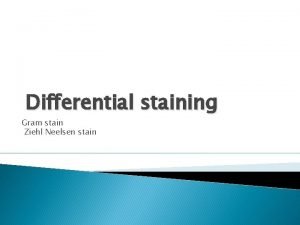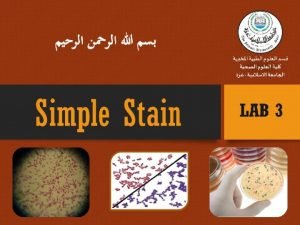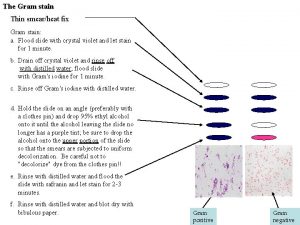Special Stain Cytochemical Reactions in Acute Leukemia Cytochemical




















![Periodic Acid – Schiff [PAS] Reaction: �Purpose: �Diagnosis of some acute lymphocytic leukemia �subtypes Periodic Acid – Schiff [PAS] Reaction: �Purpose: �Diagnosis of some acute lymphocytic leukemia �subtypes](https://slidetodoc.com/presentation_image_h/a1b484417646f503a03497fc9ad9b616/image-21.jpg)
![Periodic Acid – Schiff [PAS] Reaction Giant multinucleate late normoblasts (left). Granular PAS positivity Periodic Acid – Schiff [PAS] Reaction Giant multinucleate late normoblasts (left). Granular PAS positivity](https://slidetodoc.com/presentation_image_h/a1b484417646f503a03497fc9ad9b616/image-22.jpg)






- Slides: 28

Special Stain

Cytochemical Reactions in Acute Leukemia Cytochemical Reaction Cellular Element Stained Myeloperoxidase (MPO) Neutrophil primary Myeloblasts strong positive; granules monoblasts faint positive Sudan Black B (SBB) Phospholipids Myeloblasts strong positive; monoblasts faint positive Specific esterase Cellular enzyme Myeloblasts strong positive Nonspecific esterase (NSE) Cellular enzyme Monoblasts strong positive Glycogen and related substances Variable, coarse or block-like positivity often seen in lymphoblasts and pronormoblasts, myeloblasts usually negative although faint diffuse reaction may occasionally be seen Periodic acid-Schiff Blasts Identified

Leukocyte Alkaline phosphatase (LAP): �Purpose: Distinguishing the cells of leukemoid reactions with increase activity from these of (CML) with decreased activity. �Principle: Alkaline phosphatase Activity is present in varying degrees in the neutrophil and band form of the granulocytes /some times in B lymphocytes

Leukocyte Alkaline phosphatase (LAP) Negative LAP reaction Positive LAP reaction

1 -Leukocyte Alkaline phosphatase (LAP): �Interpretation: �Count 100 neutrophils and score them (0/+4), then calculate the final score by adding the total scores. �Grading: �*(0) No stain �*(+1) Faint stain �*(+2) Moderate stain �*(+3) Strong stain �*(+4) Strong stain without cytoplasmic background �Normal Range: 30 -185

LAP elevated in: LAP decreased in: Leukomoid reaction. CML. Pregnancy Paroxymal Nocturnal Hemoglobinuria. Polycythemia vera. Sickle cell anemia. Aplastic anemia. Hypophosphatasia. Multiuple myeloma Obstructive juindice. Hodgkins` disease.

**The following diseases will not affect LAP result: 1. 2. 3. 4. Untreated hemolytic anemia. Lymphosarcoma. Viral hepatitis. Secondary polycythemia.

Peroxidase stain : �Purpose: To differentiate a myelogenous or monocytic leukemia from acute lymphocytic. leukemia �Principle: �Peroxidase is present in the primary azurophilic granules of neutrophil, eosinophil and monocyte & activity increased with maturation, no activity is found in red cells or lymphocytes.

Myeloperoxidase (MPO) Bluish-black granules red brown precipitate

Myeloperoxidase stain, bone marrow aspirate The red granular staining peroxidase activity.

Peroxidase stain : �Red – brown peroxidase found in: neutrophil and eosinophil {promyelocyte – Metamyelocyte} �Finely granular staining found in: - Monocyte �Negative stain found in: ( early Myeloblast, lymphblast, basophiles and plasma cell)

Notes: �In acute leukemia, infection & myelodysplasia neutrophils show (-ve) stain �Increase in CML* �Basophile May stain +ve in granulocytic leukemia �Peroxidase stain show results similar to those of sudan Black B stain

Sudan Black B: �Purpose: To distinguish acute myelogenous and monocytic leukemia from lymphocytic leukemia. �Principle: Sudan black B dye is fat soluble, then it stains fat particles (Steroles, phospholipids and neutral fats) which present in the primary and secondery granules of myelocytic and monocytic cells.

Sudan Black B Positive sudan black B (SBB) stain in a patient with AML , Not the black staining cytoplasmic granules in the myeloblasts

Interpretation: �Myelogenous cells show coarse staining granules with faint staining pattern for myelobast and increase staining with maturation. �Auer rods are +vely stained. �Monocytic cells show finely scatterd granules. �-ve lymphoctic staining except Burkitt`s lymphoma cells, may show +ve staining vacuoles.

Acid phosphatase ( with tartrate resistance) �Purpose: diagnosis of hairy cell leukemia. �Principle: ACP enzyme present in myelocytic, lymphocytes, monocytic, plasma cell, and platelets in these cells ACP activity will inhibited in the presence of (L-tartarate) and give no color, while hairy cell ACP will not inhibited and give (+ve).

Acid phosphatase ( with tartrate resistance) Hairy cell leukemia, TRAP stain. Acid phosphatase reaction after incubation with tartaric acid. Granular staining is seen in the lymphocytes.

Non Specific Esterase: {with fluoride inhibition} �Purpose: Differentiate myelocytic and monocytic leukemia. �Principle: WBCS contain esterases, a group of lysosomal enzymes

Non Specific Esterase: {with fluoride inhibition} NSEs α-naphthyl acetate positivity in M 5 b. Not the granular positivity in the monoblasts and immature monocytes

Interpretation �(+ve) brick – red staining which found in: Megakaryocyte and platelets, Histocyte, Macrophage, Monocyte & Lymphoblast of ALL �(-ve) for granulocytes �**If fluoride added, only monocyte non specific esterase will be inhabited.
![Periodic Acid Schiff PAS Reaction Purpose Diagnosis of some acute lymphocytic leukemia subtypes Periodic Acid – Schiff [PAS] Reaction: �Purpose: �Diagnosis of some acute lymphocytic leukemia �subtypes](https://slidetodoc.com/presentation_image_h/a1b484417646f503a03497fc9ad9b616/image-21.jpg)
Periodic Acid – Schiff [PAS] Reaction: �Purpose: �Diagnosis of some acute lymphocytic leukemia �subtypes of AML �M 6 �Principle: the stain indicates the presence of muccoproteins , glycoproteins and high molecular weight carbohydrates in blood cells.
![Periodic Acid Schiff PAS Reaction Giant multinucleate late normoblasts left Granular PAS positivity Periodic Acid – Schiff [PAS] Reaction Giant multinucleate late normoblasts (left). Granular PAS positivity](https://slidetodoc.com/presentation_image_h/a1b484417646f503a03497fc9ad9b616/image-22.jpg)
Periodic Acid – Schiff [PAS] Reaction Giant multinucleate late normoblasts (left). Granular PAS positivity in proerythroblasts and homogeneous positivity in the later normoblasts

Interpretation: �Normally all blood cells are (+ve) but Erythroblasts (-ve) �Diffused stain pattern (Granulocytes) �Granular stain (lymphocytes and monocytes) �Plts deeply stained �n. RBCs (-ve) stain � In diseases: � In CML, lymphosarcoma and Hodgkins` disease (+ve) staining granules will increase. � n. RBCs in M 6, thalassemia and other types of anemia may give [+ve] reaction.

Positive PAS stain acute megakaryocytic leukemia AML, M 7. Positive PAS stain in ALL PAS positivity in M 6. Not the intense staining of the large abnormal erythroblast.

Specific esterase or chloroacetate �Principle: Interpretation: �Myeloid cells (+ve) �Monocyte and basophile (–ve) to weak (+ve) �Other cells {lymph – plasma –megakaryocyte – nrbc } (-ve) �Auer rods (+ve)

Specific esterase or chloroacetate Naphthol (AS-D) Chloroacetate Esterase stain in a patient with AML, M 2. Not the bright red staining indicating that these two blasts are of myeloid origin.

Iron stain (Prussian Blue Reaction): �Principle: �Sidrotic granules are found in the cytoplasm of developing cells in [BM] in the form of Ferric [Fe+3]. �Perls' reagent is formed of (Potassium Ferricyanide + HCL) �Sidrotic granules are found in n. RBCs, some reticulocytes

Sidrotic granules are found in n. RBCs, some reticulocytes
 Periodic acid schiff stain principle
Periodic acid schiff stain principle Sudan black stain aml
Sudan black stain aml Clinicaloptions
Clinicaloptions Heinz bodies
Heinz bodies Acute mylogenous leukemia
Acute mylogenous leukemia Afb staining procedure for sputum
Afb staining procedure for sputum Chemical reactions section 3 reactions in aqueous solutions
Chemical reactions section 3 reactions in aqueous solutions Chemical reactions section 2 classifying chemical reactions
Chemical reactions section 2 classifying chemical reactions Unit 5 chemical reactions answers
Unit 5 chemical reactions answers Balancing redox reactions in acidic solution
Balancing redox reactions in acidic solution Section 2 classifying chemical reactions worksheet answers
Section 2 classifying chemical reactions worksheet answers Asparagine
Asparagine Linelidomide
Linelidomide Leukemia
Leukemia Ectomy examples
Ectomy examples Acute and chronic
Acute and chronic Mark juckett md
Mark juckett md Hairy cell leukemia
Hairy cell leukemia Leukemia
Leukemia Leukemia statics
Leukemia statics Chronic myeloid leukemia
Chronic myeloid leukemia Limfoblast
Limfoblast What is the difference between lymphoma and leukemia
What is the difference between lymphoma and leukemia Lll leukemia
Lll leukemia Prefix chondr
Prefix chondr Chronic myeloid leukemia
Chronic myeloid leukemia Funkcie krvi
Funkcie krvi Cml stages
Cml stages Nk leukemia
Nk leukemia



